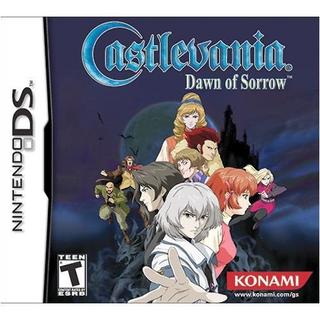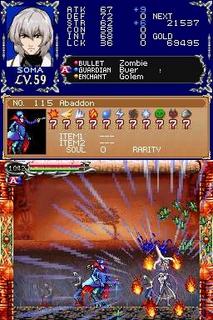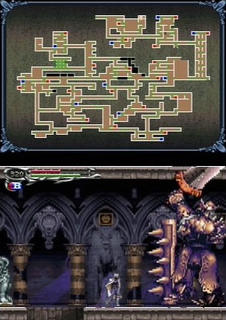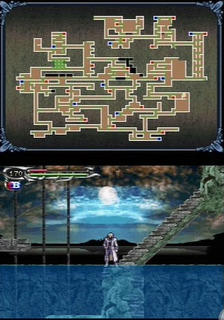 We really like our DSes here at Two Assholes and here's yet another game that exceeds expectations of what a portable game can be. The Castlevania series has grown a cult following in the last few years thanks to a series of fantastic games for Game Boy Advance. They used to be console favorites however with the advent of 3D and the plummeting sales of anything 2D, the consoles have only seen one Castlevania game since the sublime Symphony of the Night (not counting the ill-concieved 3D Castlevania game for N64). Now the series has made the jump to Nintendo's dual screened handheld and we're here to share with you a bit about the game based on the bit we've played so far.
We really like our DSes here at Two Assholes and here's yet another game that exceeds expectations of what a portable game can be. The Castlevania series has grown a cult following in the last few years thanks to a series of fantastic games for Game Boy Advance. They used to be console favorites however with the advent of 3D and the plummeting sales of anything 2D, the consoles have only seen one Castlevania game since the sublime Symphony of the Night (not counting the ill-concieved 3D Castlevania game for N64). Now the series has made the jump to Nintendo's dual screened handheld and we're here to share with you a bit about the game based on the bit we've played so far.Dawn of Sorrow's story takes place one year after the events in Aria of Sorrow, marking the first time that a Castlevania game has directly followed another's plot line. In it, you control Soma Cruz, the person who is destined to become the next incarnation of Dracula. Now, a mysterious cult wants to release the power of the Lord of Darkness and it's (of course) Soma's job to stop them. In the tradition of this line of games, this cult has constructed a modern version of Castlevania to house the Dark Lord upon his resurrection. And, convieniently, they've already filled it with baddies.
 Of course, in any Castlevania game, a discussion of the story is largely irrelevant because the story usually sucks anyways. Besides, we play these games for the gameplay. And how. Dawn of Sorrow features the same Tactical Soul system featured in Aria. Basically, when you kill an enemy it has a chance to 'drop' its soul. When it does, Soma can dominate the soul and take its powers as his own. Every enemy in the game has a potential to drop its soul, providing you with a virtually bottomless bag of tricks to pull from. One of the beefs I have with this system is that it replaces the old Subweapon system that the series has harbored for so long. Since these are undead enemies, it's pretty obvious they're not going to be wielding Holy Water or Crosses so those subweapons have been effectively eliminated from the series. Another thing I'm not sure I like about the Soul system is that there are a great deal of souls that just aren't that useful. One of the really nice things about the subweapon system was that all of them were useful in some way or another even into the late stages of the game.
Of course, in any Castlevania game, a discussion of the story is largely irrelevant because the story usually sucks anyways. Besides, we play these games for the gameplay. And how. Dawn of Sorrow features the same Tactical Soul system featured in Aria. Basically, when you kill an enemy it has a chance to 'drop' its soul. When it does, Soma can dominate the soul and take its powers as his own. Every enemy in the game has a potential to drop its soul, providing you with a virtually bottomless bag of tricks to pull from. One of the beefs I have with this system is that it replaces the old Subweapon system that the series has harbored for so long. Since these are undead enemies, it's pretty obvious they're not going to be wielding Holy Water or Crosses so those subweapons have been effectively eliminated from the series. Another thing I'm not sure I like about the Soul system is that there are a great deal of souls that just aren't that useful. One of the really nice things about the subweapon system was that all of them were useful in some way or another even into the late stages of the game. The DSs hallmark feature is the touch screen and while it sees some use in this game, it tends to be a bit cumbersome switching from playing the game to using the touch screen. Thankfully, you aren't forced to use the touch screen that much and are usually given ample warning when you will need to whip the stylus out for some quick pokes. The most notable use of the touch screen is during boss fights. When you open certain doors, a Magic Seal displays the pattern on the screen that you need to kill the boss. When the boss hits zero HP, a Magic Seal template appears on the screen prompting you to draw the correct seal. When you do, the boss is permanently killed. If you screw up or take too long, the boss regains some HP and the fight continues until he reaches zero and you get another chance to draw the seal again. The seals I've seen thus far have not been complex, however there's one displayed during the intro sequence to the game that looks as if it'd have me tearing my hair out.
The DSs hallmark feature is the touch screen and while it sees some use in this game, it tends to be a bit cumbersome switching from playing the game to using the touch screen. Thankfully, you aren't forced to use the touch screen that much and are usually given ample warning when you will need to whip the stylus out for some quick pokes. The most notable use of the touch screen is during boss fights. When you open certain doors, a Magic Seal displays the pattern on the screen that you need to kill the boss. When the boss hits zero HP, a Magic Seal template appears on the screen prompting you to draw the correct seal. When you do, the boss is permanently killed. If you screw up or take too long, the boss regains some HP and the fight continues until he reaches zero and you get another chance to draw the seal again. The seals I've seen thus far have not been complex, however there's one displayed during the intro sequence to the game that looks as if it'd have me tearing my hair out.The game also uses the touch screen for some puzzle solving action. You gain the ability early on in the game to break blocks of ice by simply touching the screen. You can use this ability to carve paths through certain rooms or to simply break them because they're in your way. There is also an ingenious slide puzzle where you can use the stylus to move puzzle pieces on a wall around to arrange an upcoming series of rooms to your liking.
One of the Castlevania series biggest claims to fame has always been the sound track. Dawn of Sorrow provides a pretty standard Castlevania sound track chock full of moody goodness. There are a few upbeat songs, a few meandering ones and everything in between and all injected with some creepy-ish motifs. While the composition at work is top notch, I'm a bit disappointed with the sound quality of Dawn of Sorrow's soundtrack. With audio compression technology the way it is nowadays, it surprises me that the developers didn't go with the prerecorded bliss that is Symphony of the Night's soundtrack and instead went with MIDI sounding tunes.
 Castlevania is also one of the last holdouts of the 2D age. Back when I was a young 'un, everything was 2D. Now this new-fangled 3D seems to have taken over and while its fun, even the best 3D games can't hold a candle to the 2D games of yore. And on the DS, 2D looks better than ever. Dawn of Sorrow uses the 3D capabilitys of the DS to breathe life into its baddies in a big way. Similar to the way Symphony of the Night used the capability, Dawn of Sorrow uses this power to fashion massive multijointed, rotating enemies that have to be seen to be believed. Combine that with the top notch art, gorgeous parallax scrolling backgrounds, and the animation that Castlevania is known for and you have one of the most beautiful games the DS has seen yet. Castlevania has never been a slouch in the graphics department and Dawn of Sorrow carries on the fine tradition of being the best 2D in the biz.
Castlevania is also one of the last holdouts of the 2D age. Back when I was a young 'un, everything was 2D. Now this new-fangled 3D seems to have taken over and while its fun, even the best 3D games can't hold a candle to the 2D games of yore. And on the DS, 2D looks better than ever. Dawn of Sorrow uses the 3D capabilitys of the DS to breathe life into its baddies in a big way. Similar to the way Symphony of the Night used the capability, Dawn of Sorrow uses this power to fashion massive multijointed, rotating enemies that have to be seen to be believed. Combine that with the top notch art, gorgeous parallax scrolling backgrounds, and the animation that Castlevania is known for and you have one of the most beautiful games the DS has seen yet. Castlevania has never been a slouch in the graphics department and Dawn of Sorrow carries on the fine tradition of being the best 2D in the biz.Speaking of graphics, it turns out the DS uses its extra screen to fulfill some of the more mundane interface tasks and clear up the main screen of clutter. You can use the Select button at any time to change the top screen from the Map to the Stats screen. The map screen is a pretty typical Castlevania/Metroid map, showing you where you've been and where you still need to explore. The really nice thing about it is that its displayed all the time if you want it to, clearing up the bottom screen of interface clutter. Press the Select button to switch to the Stats screen. Here, Soma's current equipment and souls are displayed, along with the weak points and vital statistics of the last enemy you took a swat at. Both are handy features and I'm sure you'll find yourself switching between both screens often to find out where you are and to discern your enemies' weaknesses.
Castlevania: Dawn of Sorrow has been a refreshing blast to play so far. We will bring you a full review of the game when (and if) we have the time to complete it.
No comments:
Post a Comment